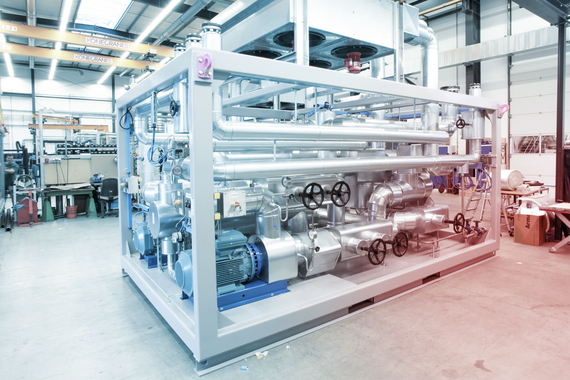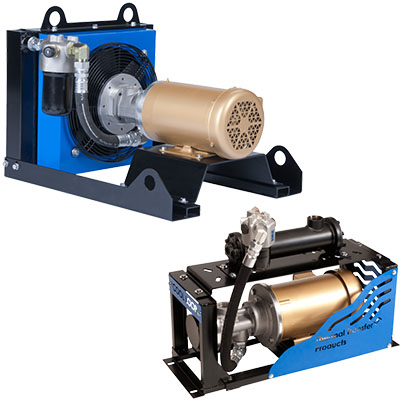Developments in Heat Transfer Systems: What You Required to Know for Optimum Efficiency
Technologies in Heat transfer systems are changing efficiency throughout various sectors. Advanced materials like graphene and nanofluids promise substantial improvements in thermal conductivity. Meanwhile, the assimilation of IoT and maker knowing uses chances for real-time monitoring and improved power effectiveness. The landscape of thermal monitoring is rapidly evolving. Understanding these advancements is necessary for attaining perfect system efficiency and sustainability in the future. What details improvements are shaping this transformation?
Arising Products for Enhanced Heat Transfer

Advanced Heat Exchanger Styles
While standard Heat exchangers have served their objective in different applications, progressed designs are now emerging to fulfill the boosting demands for effectiveness and performance. These ingenious designs, such as plate, shell-and-tube, and finned-tube Heat exchangers, include boosted area and enhanced circulation patterns to boost thermal transfer rates. Furthermore, compact styles enable decreased area needs without compromising performance. Advanced materials, such as composites and corrosion-resistant alloys, additionally improve resilience and efficiency under severe problems. Simulation technologies and computational fluid dynamics are significantly used to improve these layouts, making certain peak Heat transfer qualities. As markets look for to lessen power intake and take full advantage of output, the fostering of innovative Heat exchanger styles is pivotal in accomplishing these purposes.
The Role of Nanotechnology in Heat Transfer
Nanotechnology plays a vital role in improving thermal conductivity within Heat transfer systems. By controling products at the nanoscale, researchers have accomplished considerable improvements in energy efficiency. These developments not just optimize efficiency however additionally contribute to even more lasting energy options.
Improved Thermal Conductivity
Significant developments in thermal conductivity have actually arised with the application of nanotechnology, transforming Heat transfer systems throughout different industries. By integrating nanoparticles into Heat transfer fluids and products, researchers have attained amazing boosts in thermal conductivity. These nanoparticles, such as carbon nanotubes, graphene, and metal oxides, improve the Heat transfer properties as a result of their high surface area and unique thermal attributes. The resulting composites show enhanced performance in applications varying from electronics cooling down systems to sustainable power innovations. The capability to tailor the size, form, and make-up of nanoparticles enables for maximized thermal administration remedies. As an outcome, nanotechnology continues to play a crucial role in the advancement of more effective and reliable Heat transfer systems, leading the way for boosted industrial applications.
Energy Efficiency Improvements

Combination of IoT in Heat Transfer Solutions
The integration of IoT in Heat transfer systems presents the application of wise sensing units that enhance operational performance. These sensing units enable real-time data monitoring, enabling prompt adjustments and optimizations. This technical development has the potential to significantly boost performance and power administration in Heat transfer applications.
Smart Sensors Execution
As Heat transfer systems progress, the integration of smart sensing units via the Internet of Things (IoT) has arised as a transformative approach. These sensors enable real-time surveillance of flow, stress, and temperature rates, improving system performance and dependability. By collecting and transmitting information, they promote proactive upkeep, decreasing the risk of system failures. In addition, wise sensing units add to power financial savings by refining functional criteria read the article based on ecological conditions. Their capability to assess abnormalities and patterns enables educated decision-making, guaranteeing peak performance of Heat transfer systems. As industries progressively embrace this technology, the application of smart sensors stands to revolutionize exactly how Heat transfer systems are managed, leading the way for greater sustainability and enhanced performance outcomes.
Real-Time Information Tracking
How can real-time information monitoring boost the efficiency of Heat transfer systems? By integrating Internet of Points (IoT) technology, Heat transfer systems can utilize continuous data collection from wise sensors. This real-time surveillance enables instant evaluation of temperature level, circulation, this link and stress prices, enabling operators to determine ineffectiveness immediately. Adjustments can be made to optimize efficiency, lower energy consumption, and prolong devices life-span. Additionally, anticipating upkeep can be implemented, reducing unexpected downtime and pricey repair services. The capability to visualize efficiency metrics with control panels boosts decision-making, cultivating a positive strategy to system administration. Ultimately, real-time data monitoring not only improves functional effectiveness yet likewise contributes to sustainability goals within industrial processes.
Energy Effectiveness and Sustainability Trends
Power effectiveness and sustainability patterns are improving the landscape of Heat transfer systems, driving technology and compliance across different markets. Organizations are significantly prioritizing energy-efficient designs to minimize functional costs and minimize ecological impacts. The combination of eco-friendly power sources is coming to be more prevalent, enabling Heat transfer systems to run sustainably while satisfying regulative demands. Additionally, developments in modern technologies and products promote reduced energy usage and improve overall performance. Lifecycle assessments are also gaining traction, permitting business to examine the environmental impact of Heat transfer systems from manufacturing to disposal. This emphasis on sustainability not only supports business responsibility yet additionally placements companies competitively in a market where customers progressively favor eco-friendly options. Subsequently, energy performance and sustainability remain important factors to consider for future advancements in Heat transfer modern technology.
Technologies in Thermal Management Solutions
While the demand for effective Heat transfer proceeds to climb, technologies in thermal management options are arising to address both performance and sustainability obstacles. Advanced products, such as phase adjustment materials and nanofluids, are being created to improve Heat transfer effectiveness - DVS Heat Transfer Systems. These products boost thermal conductivity and permit far better temperature level law in different applications. In addition, innovations like energetic thermal control systems are getting grip, making it possible for real-time modifications to manage Heat circulation efficiently. These systems add to power savings and decrease the environmental influence of thermal processes. The assimilation of IoT in thermal administration facilitates surveillance and anticipating maintenance, guaranteeing enhanced performance and longevity of Heat transfer systems. Overall, these technologies represent substantial strides towards even more lasting thermal administration methods
Future Directions in Heat Transfer Modern Technology
Arising innovations in thermal management remedies indicate an appealing future for Heat transfer technology. Scientists are increasingly concentrating on creating products with remarkable thermal conductivity and enhanced power performance. Technologies such as nanofluids, which contain suspended nanoparticles, provide substantial renovations in Heat transfer performance. Furthermore, the combination of smart materials that adapt to varying temperature problems is gaining traction, enabling for even more efficient and responsive systems. The increase of additive manufacturing techniques is also allowing the style of intricate Heat exchanger geometries that enhance liquid flow. The implementation of maker discovering formulas is expected to change the optimization of Heat transfer systems, helping with anticipating maintenance and efficiency enhancement. Jointly, these developments are positioned to change the landscape of Heat transfer innovations in various sectors.

Frequently Asked Inquiries

Exactly how Do I Select the Right Heat Transfer System for My Application?
Selecting the best Heat transfer system involves assessing application requirements, including temperature level ranges, liquid homes, and effectiveness needs. Assessing system types, maintenance considerations, and cost-effectiveness likewise plays a necessary duty in making a notified choice.
What Are the Upkeep Requirements for Advanced Heat Exchangers?
Upkeep demands for advanced Heat exchangers typically include normal examinations, keeping an eye on for leaks, cleaning of surfaces, and assuring optimal circulation prices. Adhering to producer guidelines assurances reliable procedure and extends the tools's lifespan.
Just How Do Environmental Aspects Impact Heat Transfer Efficiency?
Environmental variables considerably affect Heat transfer effectiveness. Variations in temperature, humidity, and air flow impact thermal conductivity and convective Heat transfer, ultimately impacting system performance and demanding factor to consider during the design and operation of Heat transfer systems.
What Safety And Security Standards Relate To Heat Transfer Systems?
Safety and security requirements for Heat transfer systems normally consist of standards from companies such i thought about this as ASME and ASTM. DVS Heat Transfer Systems. These criteria address materials, layout, and operational practices to guarantee reliability, performance, and defense versus dangers in various applications
Just How Can I Troubleshoot Usual Heat Transfer System Issues?
Troubleshooting typical Heat transfer system concerns entails checking for leaks, making sure appropriate fluid flow, checking insulation honesty, and validating temperature differentials. Recognizing these elements can help keep system efficiency and stop more issues.
Nanotechnology plays an important duty in improving thermal conductivity within Heat transfer systems. Substantial innovations in thermal conductivity have arised via the application of nanotechnology, changing Heat transfer systems across different industries. Developments in thermal conductivity through nanotechnology have led the way for remarkable enhancements in energy effectiveness within Heat transfer systems. Energy efficiency and sustainability fads are reshaping the landscape of Heat transfer systems, driving advancement and conformity across various industries. The assimilation of IoT in thermal administration facilitates surveillance and anticipating upkeep, guaranteeing maximized efficiency and longevity of Heat transfer systems.